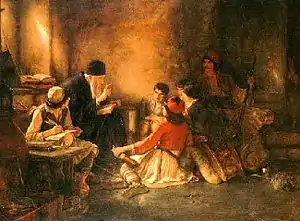Underground education
Underground education, or clandestine education, refers to various practices of teaching carried out at times and places where such educational activities were deemed illegal.

Examples of places where widespread clandestine education practices took place included education of Blacks during the slave period in the USA[1] and the Secret Teaching Organization in Poland under the Nazis.[2]
There is a Greek - mostly oral - tradition claiming that secret schools (Krifo scholio) operated during the Ottoman period. There is scant written evidence for this and many historians view it as a national myth. Others believe that the Greek secret school is a legend with a core of truth. According to certain sources, secret schools for Albanians operated in late 19th century by Albanian-speaking communities and Bektashi priests[3][4] or nationalists[5] under Ottoman rule.
.jpg.webp)
In Lithuania, clandestine schools (Slaptoji mokykla) operated almost in every village, at the end of 19th and beginning of 20th century, because of the suppression of Lithuanian language by the tsarist Russian government.[7]
In Ireland during the 18th and 19th century, "Hedge schools" were illegal schools operated by Catholics and Presbyterians; at the time, only Church of Ireland education was permitted.[8]
Secret schooling was organized in Jewish Ghettos during the Nazi regime and the German occupation in Europe. During the Taliban rule in various parts of Afghanistan (late 20th, early 21st c.), secret schools operated, mostly for women and girls.[9][10] In the 1930s and 1940s, the authoritarian nationalistic regime of Brazil took anti-immigrant measures, especially against the Japanese. Japanese and other foreign schools, languages and printed material were restricted, and a compulsory assimilation program was instituted. Japanese schools became illegal in 1938. During that period, Japanese immigrants established secret schools and a newspaper in Japanese was printed.[11]
See also
References
- Washington, Booker T. (1997). "Education of the Negro". In Sigler, Julius A.; Huston, Anne Marshall (eds.). Education: Ends and Means. University Press of America. pp. 264–269. ISBN 978-0-7618-0452-9.
- (in Polish) Ryszard Czekajowski, Tajna edukacja cywilna w latach wojenno-okupacyjnych Polski 1939-1945
- Selçuk Akşin Somel, The Modernization of Public Education in the Ottoman Empire, 1839-1908. BRILL, 2001, σ. 206.
- Clayer, Natalie (1995). "Bektachisme et nationalisme albanais". In Popovic, Alexandre; Veinstein, Gilles (eds.). Bektachiyya: Études sur l'ordre mystique des Bektachis et les groupes relevant de Hadji Bektach. Istanbul: Isis. p. 281.
- Shinasi A. Rama, Nation Failure, Ethnic Elites, and Balance of Power, Springer, 2019, p. 95: "... the intellectuals organized and sought the right to teach the Albanian language, and nationalist militantism was manifested in the growing sacrifices of the Albanians of all strata that were donating, paying for the private secret schools, funding publications, and so on."
- Saulius A. Suziedelis, Historical Dictionary of Lithuania, Scarecrow Press, 2011 p. 326
- K. Žukauskas, On the clandestine teaching in Lithuania, Psychology (Psichologija), Vilnieaus Universitetas Faculty of Philosophy, 1972, No 12 Abstract in english.
- Lyons, Tony (October 26, 2016). "'Inciting the lawless and profligate adventure'—the hedge schools of Ireland". History Ireland.
- Afghan girls risk their lives to go to secret school, The Guardian. Sep. 30, 2006
- Inside Afghanistan's secret schools, The Guardian, July 2, 2001
- Daniela de Carvalho, Migrants and Identity in Japan and Brazil: The Nikkeijin. Routledge, 2003. Chapter "From 1930 to 1954". Page number not available.